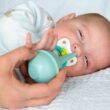If you’ve ever looked closely at your newborn’s face and thought their nostrils looked small or even “closed,” you’re not alone. Many parents worry that their baby’s tiny nose makes it hard for them to breathe properly — especially when they sound snuffly or congested. The truth is, normal newborn nostrils are often much smaller and narrower than adult ones, and that’s completely okay.
In fact, nasal sounds, mild congestion, and even a bit of visible mucus are part of healthy newborn breathing. Because infants are obligate nose breathers, keeping their nasal passages clear is essential. Using gentle tools like a nasal aspirator baby from Momcozy can safely remove excess mucus and make breathing easier, especially during feeding and sleep.
Why Newborns Are Naturally “Noisy” and Snuffly Breathers
One of the first surprises for new parents is discovering how noisy their baby can be. Little grunts, snorts, and sniffles are part of daily life during those first few months. This happens because newborns have very narrow nasal passages that easily amplify even the smallest airflow sounds.
Most of the time, these sounds aren’t a sign of illness or blockage. Instead, they reflect your baby’s developing airway and natural adjustment to breathing outside the womb. The sounds are particularly noticeable when they’re feeding or sleeping on their back — times when mucus tends to shift inside their tiny nasal passages.
The Small Tube Effect: Understanding the Anatomy of Newborn Nostrils
Your baby’s nostrils are part of a small, soft network of airways designed for short breaths. The nasal passages are lined with delicate tissue that swells easily, and even a little dryness or mucus can narrow the space further.
Because of this “small tube effect,” a small amount of mucus that wouldn’t bother an older child can make a newborn sound congested. This is also why it’s so important to use gentle methods when cleaning the nose — harsh suction or deep insertion can irritate the lining and make things worse.
Visual Check: What Do Healthy, Normal Newborn Nostrils Look Like?
Healthy newborn nostrils are typically:
- Small and slightly oval or round in shape
- Moist (but not runny) inside
- Free of crusty buildup or thick mucus
- Expanding slightly with each breath
You might notice that your baby’s nostrils appear to “flare” when they breathe — especially when crying or feeding. Occasional flaring is normal and simply indicates that your baby is working a bit harder to draw in air.
The Mystery of the Mucus: Why Babies Have Congestion Even When Not Sick
Many newborns sound congested even when they aren’t sick. This is due to a combination of dry indoor air, leftover amniotic fluid, and immature nasal glands. These glands produce mucus as a natural defense mechanism, helping to trap dust, allergens, and tiny particles before they reach the lungs.
So, even when your baby seems healthy, you might see little boogers or hear snuffly breathing — and that’s completely normal. It’s their body’s way of keeping the airway clean. The goal isn’t to eliminate all mucus but to prevent buildup that can block airflow.
Dealing with Boogers: Safe and Gentle Ways to Clear the Nasal Passageway
The safest way to clear a newborn’s nose is through moisture and gentle suction. Start by using a few drops of saline solution in each nostril to loosen the mucus. Then, use a soft, gentle device such as a nasal aspirator baby to draw out the loosened mucus. Momcozy’s electric aspirators are designed specifically for newborns, with gentle suction that’s safe for delicate nasal tissue.
Avoid cotton swabs, fingers, or hard tips — these can irritate or injure your baby’s nasal passages. Also, don’t suction too frequently; once or twice a day is usually enough unless your pediatrician advises otherwise.
The Crucial Link: How Nasal Breathing Affects Feeding and Sleep
Newborns rely heavily on nose breathing for both feeding and sleeping. Since they don’t instinctively breathe through their mouths until they’re a bit older, even mild congestion can make it hard for them to latch or sleep peacefully.
If your baby is struggling to nurse, pauses frequently during feeding, or seems fussy while lying down, nasal blockage might be the cause. Clearing their nose before feeding or bedtime ensures they can breathe comfortably — helping them eat well, rest better, and stay calm.
When to Worry: Signs That Snuffling Is Turning Into Distress
While mild congestion and noisy breathing are normal, some signs indicate more serious breathing trouble. Contact your pediatrician immediately if your baby:
- Has persistent nostril flaring or visible effort while breathing
- Shows chest retractions (the skin pulling in between ribs or under the ribs)
- Has a bluish tint around the lips or face
- Struggles to feed due to breathing difficulty
- Produces thick yellow or green mucus for several days
- Has a fever or seems unusually drowsy or irritable
These could point to conditions like a respiratory infection, allergies, or structural nasal issues such as choanal atresia (a congenital narrowing or blockage of the nasal passage).
Creating the Ideal Environment: Using Humidifiers and Saline for Support
Keeping your baby’s airways moist is one of the best ways to prevent congestion. A cool-mist humidifier in your baby’s room helps add moisture to dry air, especially during air-conditioned or winter months.
Running the humidifier during sleep times can prevent dry, sticky mucus that blocks the nose. Pair this with occasional saline drops and gentle suction to maintain a clear airway. Regular cleaning of the humidifier is also crucial to prevent mold or bacterial growth.
Summary
Understanding normal newborn nostrils helps you distinguish between what’s healthy and what needs medical attention. Most of the time, a baby’s small, snuffly nose is just a part of their anatomy — not a sign of illness. Their tiny nasal passages make every breath audible, but as they grow, breathing will naturally become quieter and more effortless.
When congestion does occur, a gentle suction routine can make all the difference. Using a nasal aspirator baby from Momcozy ensures safe, efficient mucus removal without discomfort. Combine that with moisture control and a clean, humid environment to keep your little one’s nose and sleep happy.




